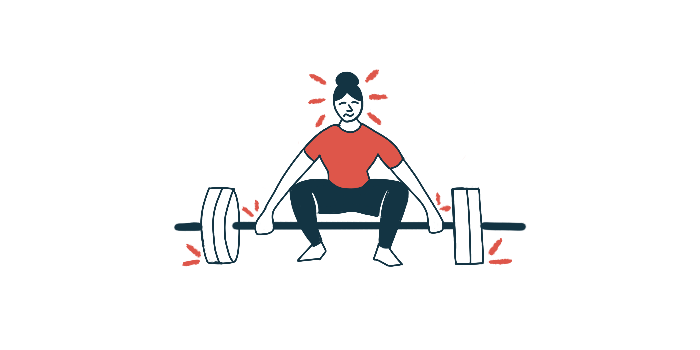Lower Limb Resistance Training Leads to Upper Limb Strength Gains
Resistance training has been shown to benefit walking, balance

Ten weeks of lower limb fast-velocity concentric resistance training (FVCRT) led to muscle strength gains in both the upper and lower limbs in people with multiple sclerosis (MS), according to a recent study.
This form of resistance training, which requires muscles to be maximally contracted as quickly as possible when using conventional weight machines, also increased walking speed and endurance and was associated with feeling less overwhelming pain and fatigue.
The study’s researchers suggested the beneficial effects could be related to greater neural adaptations than with other types of resistance training, but future studies are needed to confirm these nerve cell changes.
The study, “Effects of fast-velocity concentric resistance training in people with multiple sclerosis: A randomized controlled trial,” was published in Acta Neurologica Scandinavica.
Muscle weakness is a common and debilitating symptom of MS that can lead to poor balance and a reduced capacity for walking independently, posing significant challenges in day to day life.
Resistance training of the lower limbs can increase muscle strength in MS patients and improve walking speed and endurance. It often involves sets of repeated exercises, using weights or a person’s own body to create resistance.
FVCRT is a type of resistance training that involves rapidly contracting (clenching) muscles at the end of each repetition. It’s thought this type of training, along with directly strengthening muscles, better engages the nerve cells that communicate with muscles to facilitate movements, causing them to be more active and promote greater gains in strength.
This form of exercise has not been tested with MS patients, however, leading researchers in Spain to conduct a randomized clinical trial (NCT04452760) that evaluated the potential benefits of a 10-week FVCRT program in 30 MS patients.
Participants, 15 men and 15 women, were able to walk and most (90%) had the relapsing-remitting form of MS. They were randomly assigned to either an exercise training group or a control group that did not receive any intervention.
FVRCT training sessions were carried out three times a week. After a warmup period, patients performed a range of lower body resistance exercises using a weight machine. They were instructed to maximally contract the muscle used in the exercise quickly after the end of the movement. The weight used in each set of exercises was determined individually for each patient based on their capacity.
All participants assigned to FVRCT completed the intervention with no reported side effects.
Results showed participants in the FVCRT group experienced significant improvements in lower limb strength after training based on maximum isometric voluntary contraction (MVIC) scores, a standard method for measuring muscle strength in people with neuromuscular diseases.
Muscle strength increased by 31.7% in the right leg and 26.7% in the left leg, compared with before training. These gains were 69% greater than those observed in the control group.
Upper limb strength gain, lower pain levels
Importantly, while patients performed no exercises targeting the upper limbs, they had significantly increased hand-grip strength after the program, with improvements also being significantly greater than in controls.
These improvements might be related to changes in brain signaling and nerve cell communication that have a broader influence on muscle function, rather than effects solely on the muscles, the team hypothesized.
“Even though we only trained the lower limb muscles, it appears that the neural adaptations achieved during the 10-week of FVCRT improved strength in the untrained upper limb as well,” the researchers wrote. “This improvement in strength in the untrained limbs may be a promising alternative for people with MS who present with high levels of lower limb disability, as they could perform upper limb FVCRT and could increase lower limb muscle strength through neural adaptation.”
Gait speed and endurance were also significantly increased after FVCRT, as were some self-reported outcome measures. In particular, FVCRT led to lower levels of fatigue and catastrophic pain symptoms, while those in the control group didn’t see any changes.
FVCRT “is an effective tool in improving strength, gait, perception of fatigue and catastrophizing pain,” the researchers wrote, adding that “future lines of research should compare the effects of traditional resistance training vs. FVCRT on structural and neural adaptations in people with MS.”







